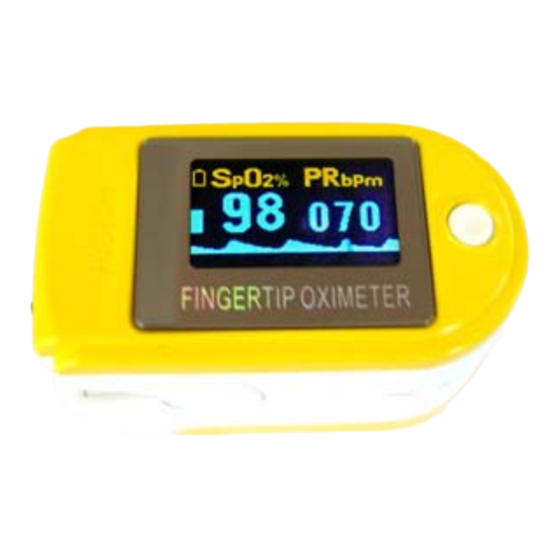Table of Contents
Advertisement
Quick Links
This Manual is written and compiled in accordance with the council directive MDD 93/42/EEC
for medical devices and corresponding standards. The Manual written is in accordance with the
Fingertip Pulse Oximeter. In case of modifications and software upgrades, you will be advised in
due time with a Modification Notice.
The Manual includes the Fingertip Pulse Oximeter's features and requirements, main structure,
functions, specifications, correct methods for transportation, installation, usage, operation, repair,
maintenance and storage, etc. as well as the safety procedures to protect both the user and
equipment. Refer to the respective chapters for details.
This manual is used for the experienced personnel who is familiar with the measure and the use of
the instrument. This manual is compiled by our company, and the copyright is possessed by our
company.
I
Advertisement
Table of Contents

Summary of Contents for AccuMed CMS-50D
- Page 1 This Manual is written and compiled in accordance with the council directive MDD 93/42/EEC for medical devices and corresponding standards. The Manual written is in accordance with the Fingertip Pulse Oximeter. In case of modifications and software upgrades, you will be advised in due time with a Modification Notice.
- Page 2 Instructions to User Dear Users, thank you very much for purchasing Fingertip Pulse Oximeter. Please read the following two pages very carefully before using this equipment. Please read these instructions carefully before using this equipment. These instructions describing the operating procedures should be followed strictly. Failure to follow these instructions can cause measuring abnormality, equipment damage and personal injury.
-
Page 3: Table Of Contents
Table of Contents 1. SAFETY ............................1 1.1. I ................... 1 NSTRUCTIONS FOR SAFE OPERATIONS 1.2. W ..........................1 ARNINGS 1.3. A ........................... 1 TTENTIONS 2. OVERVIEW ..........................1 2.1. F ..........................2 EATURES 2.2. A ....................2 NTICIPATIVE APPLICATION 2.3. -
Page 4: Safety
1. Safety 1.1 Instructions for safe operations Check the main unit and all accessories periodically to make sure that there is no visible damage that may affect patient’s safety and monitoring performance. It is recommended that the device should be inspected once a week at least. Please stop using the monitor when there is obvious damage. -
Page 5: Features
concentration in the blood. It is an important bio-parameter for the respiration. Many of the respiration disease will cause hypoxemia, even damage the patient’s life. As a result, monitoring the is indispensable in the clinical rescuing. The traditional method to measure SpO is to analyze the sample of the patient’s blood to get the partial pressure of oxygen and calculate the SpO by use... -
Page 6: Principle And Caution
b)Humidity: 35%~75% c)Pressure: 700hPa~1060hPa 3. Principle and Caution 3.1. Principle of measurement The measurement of pulse oximeter is that it uses a multi-functional oxyhemoglobinometer to transmit some narrow spectrum light bands through blood samples, and to measure attenuation of spectrum with different wavelengths according to the characteristic that RHb, O Hb, Met Hb and COHb absorb the light of different wavelength, thereby determining O Hb saturation of different... -
Page 7: Clinical Restrictions
D. The SpO sensor should not be used at a location or limb tied with arterial canal or blood pressure cuff or receiving intravenous injection. Make sure the optical path is free from any optical obstacles like rubberized fabric, otherwise it may result in venous pulsation and inaccurate measure of SpO Excessive ambient light may affect the measuring result. -
Page 8: Accessories
C. Operating current: ≤30mA : 1% D. Resolution: Pulse Rate : 1bpm :70% to 100%±2 digits, below 70% unspecified E. Accuracy: SpO Pulse rate:±2 bpm or ±2% (select larger) F. Measurement at low perfusion: The values of SpO and pulse rate can be displayed properly when pulse saturation is at 0.4%. :±4% Accuracy of SpO Accuracy of Pulse rate:±2bpm or ±2% (select larger) -
Page 9: Installation
6. Installation 6.1. View of the front panel Figure2. front view 6.2. Mounting Of The Battery 1. Refer to Figure 3. And insert the two AAA size batteries properly in the right direction , according to the “+ “and “-”symbol. 2. -
Page 10: Operating Guide
Step1. Put the end of the rope through the hole. Step2. Put another end of the rope through the first one and then tighten it. Figure4. Mount the hanging rope 7. Operating Guide A. Insert the two batteries properly to the direction, and then place the cover. Open the clip as shown in Figure 5. -
Page 11: Cleaning And Disinfecting
D. Get the information directly from screen display. When working, the display direction can be changed by pressing the button shortly. There are six modes of direction. In working item,long press can change the lighteness of the screen . When finger put into the rubber cushions of the clip, make sure nail is upturned. 8. -
Page 12: Function Specification
1. The finger is not placed inside deep 1. Place the finger properly enough. The SpO and Pulse Rate and try again. display instable 2. The finger is shaking or the patient 2. Let the patient keep calm is moving. 1. -
Page 13: Key Of Symbols
Pulse Parameter Specification Measuring range 30bpm~240bpm, (the resolution is 1bpm) Accuracy ±2bpm or±2% (select larger) Pulse Intensity Range Continuous bar-graph display, the higher display indicate the stronger pulse. Battery Requirement 1.5V (AAA size) alkaline batteries × 2 Battery useful life The two batteries can work continually 30 hours. - Page 14 Alarm inhibit...




Need help?
Do you have a question about the CMS-50D and is the answer not in the manual?
Questions and answers